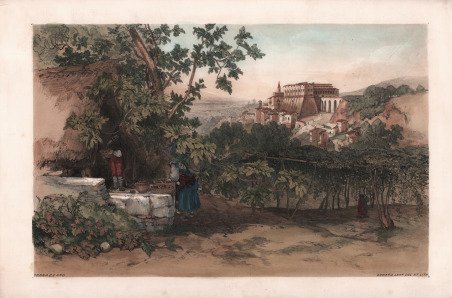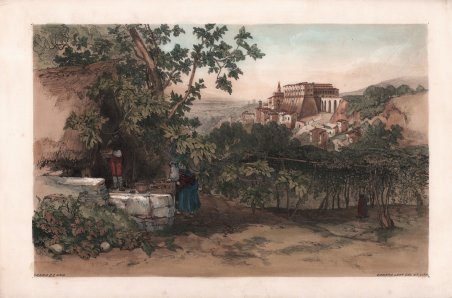Monumentale veduta della città incisa da Ignazio Sclopis e dedicata alla viscontessa Georgiana Spencer, nome con il quale viene spesso identificata. La tavola, stampata su tre lastre, costituisce il paio con il Prospetto generale di Napoli, la classica veduta della città dal mare. Le “Spencer” costituisco le più importanti vedute per misura ed impegno sulla città. “Le due vedute dedicate alla viscontessa Spencer si svolgono su tre grandi rami ciascuna, con la stessa altezza e una differenza di circa venti centimetri di lunghezza tra le due. La più piccola, con la veduta di Posillipo, mostra l’intero prospetto della riviera di Chiaia, di grandissimo interesse per questa parte della città, successivamente molto trasformata. È in tal senso singolare che uno dei prospetti più importanti della città non abbia mai ricevuto una sistemazione progettuale unitaria, conservandosi invece quel pittoresco, ma talvolta anche trito alternarsi di facciatine, tipico di una edilizia stratificata. Tra gli edifici, tutti minutamente delineati, spiccano la chiesa e il convento di S. Antonio a Posillipo con la rampa che conduce alla grotta di Posillipo, il fanzaghiano palazzo Teora Mirelli, le chiese di S. Maria della Neve, di S. Giuseppe con la facciata primitiva, di S. Maria della Vittoria con le cupole e la facciata primitive, oltre i numerosi palazzi patrizi. In primo piano si svolge inoltre una vivace scena di costume, con cavalieri, carrozze, tarantelle improvvisate bisticci, scena di pesca ed il via vai delle imbarcazioni dirette a Posillipo, che prendono terra proprio sulla spiaggia della Torretta. La veduta ha 66 riferimenti nei due cartigli laterali, ne quali è ricordata anche la recente eruzione del Vesuvio. La seconda, maggiore veduta copre, com’era ormai tradizione, tutto l'arco dalla punta di Posillipo al ponte della Maddalena. Essa ospita 68 riferimenti tipografici nel lungo cartiglio inferiore, corredato di raffigurazioni mitologiche. Anche qui, ma forse in maggior misura che nell'altra, la descrizione minuta del tessuto edilizio, decisamente topografico-vedutistica, è di prezioso ausilio per la ricostruzione dell'aspetto dei luoghi e per la storia del costume. Accenniamo soltanto, rinviando ad una specifica futura illustrazione, all'aspetto del borgo di S. Lucia, con il baluardo, le fontane sul prospetto del mare ed il casino Carafa, con il complesso della Croce di Palazzo e l'Arsenale seicentesco ancora in piedi; oppure al prospetto urbano sul porto, con i bassi edifici a due piani destinati ad uffici doganali ed amministrativi, l'edificio della Dogana della farina, già parzialmente modificato, l'Immacolatella di contro al Mandracchio - come si era chiamato, con tardivo grecismo, il porto interno o Molo piccolo, ora chiuso da un ponte (« Pontenuovo ») per la nuova strada Marina; o ancora le innumerevoli abitazioni improprie, magazzini e rimesse di imbarcazioni presenti lungo il prospetto successivo, a coprire le mura urbane, come già aveva anticipato la veduta Baratta ai primi del Seicento. Qua e là, oltre ad edifici molto bassi, si osservano anche edifici di sei piani. Sulla collina spicca la fabbrica del palazzo Reale di Capodimonte, da pochi anni sede del Musco farnesiano e, sempre sullo sfondo, in basso, al di là della ' selva di cupole e campanili della città antica, si riconosce la lunga mole dell'Albergo dei Poveri, in costruzione. Sul mare sfilano le barche con gli ordigni per la pesca a strascico. Anche qui la scena è animatissima; l'affollamento di imbarcazioni, con tutto il loro ingombrante corredo -oltre che nel porto anche lungo la spiaggia della Marina, recentemente sistemata da Carlo di Borbone – è talmente parte della città che, si può dire, difficilmente l'autore avrebbe potuto esimersi dal delinearlo, se anche avesse voluto” (cfr. Giulio Pane, in La città di Napoli tra vedutismo e Cartografia, pp. 251/253, 109. Nella veduta di Chiaia, al centro della foto si vede anche . Monumental view of the city engraved by Ignazio Sclopis and dedicated to the Viscountess Georgiana Spencer, the name by which it's often identified. The "Spencer" are the most important views of the city for their size and commitment. The two views dedicated to Viscountess Spencer take place on three large branches each, with the same height and a difference of about twenty inches in length between them. The smaller one, with the view of Posillipo, shows the entire elevation of the Riviera di Chiaia, of great interest to this part of the city, subsequently much transformed. It is in this sense singular that one of the most important elevations of the city has never received a unitary project arrangement, preserving instead that picturesque, but sometimes trite alternation of facades, typical of a stratified building. Among the buildings, all minutely outlined, stand out the church and the convent of S. Antonio a Posillipo with the ramp leading to the cave of Posillipo, the Fanzago palace Teora Mirelli, the churches of S. Maria della Neve, S. Giuseppe with the primitive facade, S. Maria della Vittoria with the domes and the primitive facade, as well as numerous patrician palaces. In the foreground there is also a lively scene of costume, with knights, carriages, tarantella improvised bickering, fishing scene and the comings and goings of the boats bound for Posillipo, which take land right on the beach of the Torretta. The view has 66 references in the two lateral cartouches, in which the recent eruption of Vesuvius is also remembered. The second, larger view covers, as was now tradition, the entire arc from the tip of Posillipo to the bridge of La Maddalena. It has 68 typographical references in the long lower scroll, accompanied by mythological representations. Here too, but perhaps to a greater extent than in the other, the minute description of the building fabric, decidedly topographical-vedutistic, is of precious help in reconstructing the appearance of places and the history of customs. We mention only, postponing to a specific future illustration, the aspect of the suburb of S. Lucia, with the bulwark, the fountains on the prospect of the sea and the casino Carafa, with the complex of the Cross Palace and the seventeenth-century Arsenal still standing; or to the urban prospect on the port, with the low two-storey buildings destined to customs and administrative offices, the building of the Customs of Flour, already partially modified, the Immacolatella against the Mandracchio - as it was called, with late Greekism, the inner port or Molo piccolo, now closed by a bridge (" Pontenuovo ") for the new Marina road; or the countless improper dwellings, warehouses and boathouses present along the next elevation, covering the city walls, as the Baratta view had already anticipated in the early seventeenth century. Here and there, in addition to very low buildings, one can also observe six-story buildings. On the hill stands out the factory of the Royal Palace of Capodimonte, since a few years seat of the Farnese Musco and, always in the background, below, beyond the forest of domes and bell towers of the old city, we recognize the long bulk of the Albergo dei Poveri, under construction. On the sea parade boats with devices for trawling. Even here the scene is very animated; the crowding of boats, with all their bulky equipment - as well as in the port also along the beach of the Marina, recently arranged by Carlo of Borbone - is so much part of the city that, we can say, the author could hardly have failed to outline it, even if he had wanted to (see Giulio Pane, in La città di Napoli tra vedutismo e Cartografia, pp. 251/253, 109. In the view of Chiaia, in the center of the picture you can also see the disappeared church and convent of San Leonardo Insula Maris, which, as the name suggests, stood on a small island in the middle of the sea, reached by a small bridge, similar to Castel dell'Ovo. Built in 1028, not being. Cfr.



Descubre cómo utilizar
Descubre cómo utilizar

